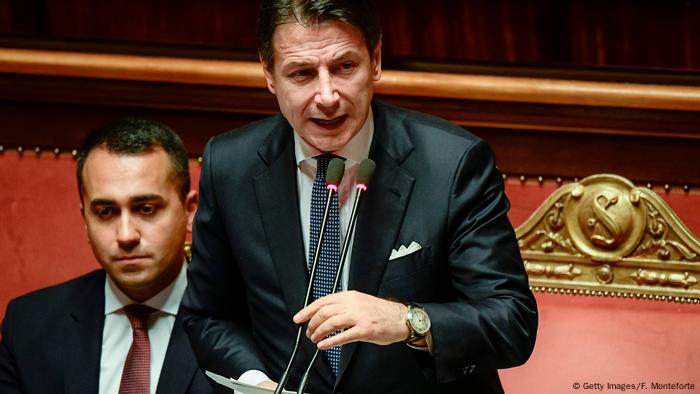Where is Italy's populist Five Star Movement headed?
Prime Minister Draghi's unity government is on the brink of collapse because an important coalition partner, the populist Five Star Movement, has pulled its support. What's the current state of the once-popular party?

Once allies: Foreign Minister di Maio (left) and Conte as prime minister in 2019
The background to the latest government crisis in Italy is a power struggle within the Five Star Movement (M5S), led by former Prime Minister Giuseppe Conte. The movement boycotted a parliamentary vote on a €26 billion ($26 billion) relief package, thereby refusing to support current Prime Minister Mario Draghi. Despite winning a vote of confidence, Draghi offered his resignation, which was then rejected by Italy's president, Sergio Mattarella.
The populist M5S, which saw itself as a counterweight to established political parties, won the largest percentage of votes in the 2018 parliamentary elections. Initially, it shared government duties with the right-euroskeptic Lega Nord (LN) party and right-wing extremists.

Street art left- and right-wing populists mocks Luigi di Maio and Matteo Salvini
This coalition broke up in 2019, when LN leader Matteo Salvini saw a chance of becoming head of government himself. Prime Minister Giuseppe Conte, then not yet formally a member of the movement, surprisingly managed to forge a new coalition with the center-left Democratic Party (PD). This new alliance, however, broke up as well.
In January 2021, Conte stepped down and was replaced as prime minister by the independent "technocrat" Mario Draghi, who led a "coalition of national unity" that included almost all parties, except the right-nationalist Brothers of Italy (FdI). Conte became leader of the M5S, which then split in June, when Foreign Minister Luigi di Maio — who had led the party till 2020 — and about 60 allies, left the party's parliamentary groups in Italy's bicameral Parliament after Conte took a critical stance toward arms deliveries to Ukraine.
Currently, there are two M5S groups in Parliament as di Maio also claims to represent the legitimate part of the movement. In addition to the split on Ukraine, the groups are at loggerheads when it comes to social policy issues. Conte supports more radical positions, whereas di Maio supports Draghi's policies.

In 2021, Mario Draghi took over government duties from his predecessor Conte
Legacy of dissent
M5S was founded in 2009 by the TV comedian Beppe Grillo, who had become a popular figure through his satiric attacks against Italy's established political parties. Grillo was supported by internet entrepreneur Gianroberto Casaleggio.
In the course of the financial crisis and protests against austerity measures in Italy, Grillo — himself barred from adopting a political post due to a previous conviction — managed to considerably increase M5S's popularity. In the 2018 parliamentary elections, M5S won the largest share of the vote in both the Chamber of Deputies and the Senate.

Beppe Grillo speaking to an audience on a square in Turin (2013)
Dozens of MPs have since left the party and joined other parliamentary groups. Recently, personnel and party manifesto votes conducted via the Rousseau online platform were seen as intransparent by many lawmakers and party members. M5S is currently polling at about 11%; it had garnered nearly 33% of the vote in 2018.
Grillo has withdrawn from the active leadership circle; he remains, however, head consultant and mentor. Roberto Casaleggio, the son of the now-deceased Gianroberto, continues to be involved with the M5S.
Political analysts view Conte's refusal to support Draghi as an attempt to position himself as a left-wing alternative prior to the upcoming parliamentary elections in 2023 — a risky undertaking in Italy's fragmented party landscape.
This article was originally written in German
No comments:
Post a Comment